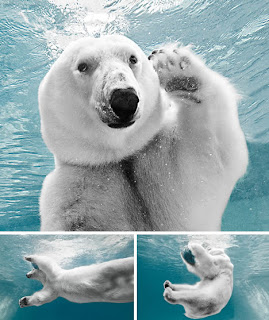Tuesday, February 1, 2011
Plight of the Polar Bear in Pictures
Seeing Double(image credit:National Geographic)
Seeing double, sadly no. In fact, according to the World Wildlife Fund (WWF), the biggest man-made threat to polar bear survival is climate change. If current warming trends continue unabated, then polar bears could soon be found only in zoos.
Snowy(image credit:National Geographic)
Look at this adorable fluffy face. Is it any wonder that the polar bear is loved by so many? Clearly, however, it is not loved by enough. Other threats to this species include hunting and the illegal harvest of polar bears.
Is Captivity the Polar Bears’ Future?(image credits:Telegraph)
If some of the scientists are correct, polar bears could be extinct by 2050. Although it is truly a delight to watch these great white beasts play in the water or entertain us at the zoo, could this someday be the only place where polar bears survive?
Starving(image credits:National Geographic,Lee,Greening Washington)
Polar Bears have sharp, jagged back teeth, and canines that are larger and sharper than grizzly teeth. They swallow their food in large chunks instead of chewing. These large carnivores are sensitive indicators of ecosystem health. But they are starving, some are starving to death.
Headache, Fight, Kiss and Make Up(image credits:National Geographic,komar,komar)
This mother bear repeatedly denied her cubs the chance to breast-feed. Without food, she cannot make the milk her cubs need. She appears to be holding her head as if she has a headache. And what mother wouldn’t be overwhelmed with worry if she could not feed her children? Even if it is humanizing these beasts, we should identify with some of their actions. They fight. They kiss and make up.
Human-like(image credits:treehugger,gamespot,350twinports,treehugger)
Not everyone sees the polar bear as a species that has some human-like tendencies. Perhaps they are sticking out their tongue at humans, thinking we had better get our act together before their kind is lost? Two bears are moving as if waltzing together. The furry beast on the bottom is kicked back and relaxed as if some of these polar bears still have a little faith in us to hurry up and act to save them and their ecosystem
Standing in the Arctic Sunset(image credit:komar)
Polar bears are so well insulated that they need to move slowly to avoid overheating. Their thick coat has a double layer of water repellent hairs that conserve heat. Under their dense fur is black skin which is good for absorbing the rays of the arctic sun.
Nuzzle and Snuggle(image credits:NationalGeographic,NationalGeographic)
Bears roam far and wide in search of food, going from iceberg to iceberg. Bears fitted with satellite collars have been tracked, proving they swim up to 150 miles in search of food. Mother bears cannot leave their cubs for such a long time since a cub relies mainly on its mother for insulation. The more the ice and ecosystem is damaged, the further the mothers need to go to find seals, their primary food. This endangers both the cub and the mother.
Momma and Cubs
Pregnant females live off stored reserves for up to 6 months. Her milk and body heat enable her cub to stay warm and grow. The mother and cubs make short trips to and from the den to get the cubs accustomed to the outside temperatures.Then the family leaves and heads toward the sea ice where the mother teaches, hunts for and protects her cubs.
Shrinking Ice(image credits:naturescrusaders,b4tea,National Geographic,Legal Planet)
Polar bears have become the iconic symbol of early victims of climate-induced habitat loss. Shrinking sea ice due to global warming is a serious threat to bears that hunt and travel on the ice. Bears depend on ice. And the ice is melting. WWF works to protect critical polar bear habitats where these bears are already stuck and stranded on land for long periods of time due to lack of ice.
1 Feb 2010,
Source : Ecoist
Subscribe to:
Comments (Atom)










